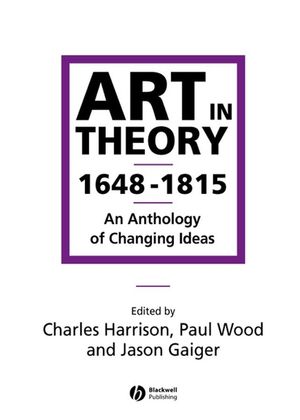Charles Harrison, Paul Wood, Jason Gaiger (eds.): Art in Theory 1648-1815: An Anthology of Changing Ideas (2001)
Filed under book | Tags: · 1600s, 1700s, 1800s, art, art criticism, art history, art theory

“Art in Theory (1648-1815) provides a wide-ranging and comprehensive collection of documents on the theory of art from the founding of the French Academy until the end of the Napoleonic Wars. Like its companion volumes, Art in Theory (1815-1900) and Art in Theory (1900-1990), its primary aim is to provide students and teachers with the documentary material for informed and up-to-date study. Its 240 texts, clear principles of organization and considerable editorial content offer a vivid and indispensable introduction to the art of the early modern period.
Harrison, Wood and Gaiger have collected writing by artists, critics, philosophers, literary figures and administrators of the arts, some reprinted in their entirety, others excerpted from longer works. A wealth of material from French, German, Italian, Spanish, Dutch and Latin sources is also provided, including many new translations.
Among the major themes treated are early arguments over the relative merits of ancient and modern art, debates between the advocates of form and color, the beginnings of modern art criticism in reviews of the Salon, art and politics during the French Revolution, the rise of landscape painting, and the artistic theories of Romanticism and Neo-classicism.
Each section is prefaced by an essay that situates the ideas of the period in their historical context, while relating theoretical concerns and debates to developments in the practice of art. Each individual text is also accompanied by a short introduction. An extensive bibliography and full index are provided.”
Publisher Blackwell, 2001
ISBN 9780631200642
1220 pages
Reviews: Richard Woodfield (Journal of Aesthetics and Art Criticism, 2003), Patricia Railing (Art Book, 2004).
PDF (updated on 2012-7-18)
Comment (0)Boris Groys: The Total Art of Stalinism: Avant-Garde, Aesthetic Dictatorship, and Beyond (1988–) [EN, IT]
Filed under book | Tags: · aesthetics, art, art criticism, art history, art theory, avant-garde, censorship, politics, russia, socialist realism, soviet union, totalitarianism

“As communism collapses into ruins, Boris Groys provokes our interest in the aesthetic goals pursued with such catastrophic consequences by its founders. Interpreting totalitarian art and literature in the context of cultural history, this brilliant essay likens totalitarian aims to the modernists’ demands that art should move from depicting to transforming the world. The revolutionaries of October 1917 promised to create a society that was not only more just and more economically stable but also more beautiful, and they intended that the entire life of the nation be completely subordinate to Communist party leaders commissioned to regulate, harmonize, and create a single “artistic” whole out of even the most minute details. What were the origins of this idea? And what were its artistic and literary ramifications? In addressing these issues, Groys questions the view that socialist realism was an “art for the masses.” Groys argues instead that the “total art” proposed by Stalin and his followers was formulated by well-educated elites who had assimilated the experience of the avant-garde and been brought to socialist realism by the future-oriented logic of avant-garde thinking. After explaining the internal evolution of Stalinist art, Groys shows how socialist realism gradually disintegrated after Stalin’s death. In an undecided and insecure Soviet culture, artists focused on restoring historical continuity or practicing “sots art,” a term derived from the combined names of socialist realism (sotsrealizm) and pop art. Increasingly popular in the West, sots-artists incorporate the Stalin myth into world mythology and demonstrate its similarity to supposedly opposing myths.”
Originally published in German as Gesamtkunstwerk Stalin, Carl Hanser, Munich and Vienna, 1988.
English edition
Translated by Charles Rougle
Publisher Princeton University Press, 1992
ISBN 0691055963, 9780691055961
126 pages
Reviews: Alla Efimova (Art Bulletin, 1992), Vyacheslav Ivanov (Slavic Review, 1993), Mary A. Nicholas (Slavic and East European Journal, 1993), Ross Wolfe (Situations, c2011), Giuliano Vivaldi (Marx & Philosophy Review of Books, 2013).
Publisher (EN)
The Total Art of Stalinism (English, trans. Charles Rougle, 1992, updated on 2012-7-18)
Lo stalinismo ovvero l’opera d’arte totale (Italian, trans. Emanuela Guercetti, 1992, added on 2019-12-14)
IDEA Arts + Society (2003–) [Romanian/English]
Filed under magazine | Tags: · activism, art, art criticism, art theory, autonomy, capitalism, contemporary art, cultural criticism, eastern europe, institutional critique, performance art, politics, romania, society, southeastern europe, theory, video art

Idea 36-37, 2010

Idea 35, 2010
“IDEA art+society is a multiannual publication produced by IDEA, Cluj. It is published under its current form since 2003.
Allegiance to the exigency of genuine theory – a theory which is, first of all, its own practice – this is the program of IDEA arts+society magazine. This means: the practice of the concerned eye, which can be rigorous solely through the unconditional solidarity with the concrete. It is a practice of thinking which is alien to any aestheticism, hostile to any institutionalized transcendence, immune to the biased fiction of ideological neutrality, and remote from the pernicious language of our contemporary culture of ‘experts.’ In brief, it is the practice of critical and defiant reflection, dramatically lacking in the intellectual-civic debates of present-day Romania.
The graphical and logical operator ‘+’ functions as the material figura of all these dimensions, to which we can add artistic education and the public influence of art. The various ways of deciphering this sign suggest the manifold articulations between the artistic and the social realm. That is, the political.”
IDEA artă + societate / IDEA arts + society
Editors: Bogdan Ghiu, Ciprian Mureșan, Timotei Nădășan (editor-in-chief), Alexandru Polgár, Adrian T. Sîrbu, Ovidiu Țichindeleanu, Raluca Voinea
ISSN 1583–8293

